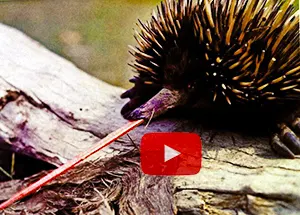Monotreme Animals Nature’s Most Unique Mammals
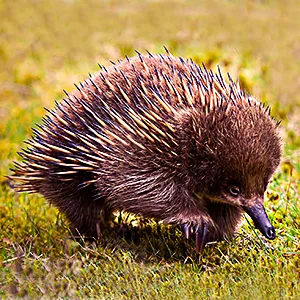
Photo: Short-beaked echidna walking
What is a Monotreme?
Monotremes are an extraordinary group of animals that have characteristics of mammals, reptiles, birds, and marsupials — all in a single animal. They lay eggs like birds and reptiles but feed their young milk like mammals. They have a beak like birds and a single opening for excretion and reproduction like marsupials, reptiles and birds. Males have a spur on their ankles, which bears poison in the case of the platypus. There are only three species of monotremes: the amphibious platypus, and two species of terrestrial echidna. Monotremes are some of the oldest mammals on Earth and are only found in Australia and New Guinea. Monotreme is pronounced mo-no-tree-m.
What Does the Word “Monotreme” Mean?
The word ' monotreme' comes from the scientific animal classification Monotremata which means "one hole" ( mono = one and treme = hole). This is because these unusual animals are mammals but have only a single rear opening, called a cloaca, serving as their anus, urinary and reproductive tract similar to reptiles and birds.
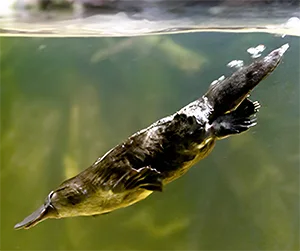
Photo: Platypus swimming underwater
Monotremes are Like Mammals
Monotremes are mammals because they:
• Produce Milk:
Monotremes lactate by producing milk (lactate) to feed their young.
• Don’t Have Teats or Nipples:
Instead, milk seeps out of special pads on the surface of the mother's abdomen from which the young animals lap it up.
• Warm Blooded:Monotremes are warm-blooded like all mammals, but have a body temperature of 30°C, which is 8°C lower than placental mammals.
Monotremes are Like Reptiles
Monotremes share several characteristics with reptiles.
• Cloaca: One opening for reproductive, digestive, and urinary systems.
• Egg-Laying: They lay leathery eggs in an external environment.
• Gait: Their legs are positioned on the sides of their body, giving them a reptilian walk.
• Brain Structure: They lack a corpus callosum, the bridge connecting the two brain hemispheres in placental mammals.
Monotremes are Like Marsupials
Monotremes and marsupials and share many similarities including:
• A Cloaca: a single opening for reproductive, digestive, and urinary systems.
• Underdeveloped Birth: Their young are born prematurely and continue to develop outside the womb.
• Protective Pouch: Female echidnas have a backward-facing pouch for carrying eggs and young, while platypuses secure their eggs on their abdomen.
• Brain: Certain features of their brains.
Monotremes are Like Birds
Monotremes also have bird-like features. These include:
• Bird-like Skull: Which is lightweight, strong, and made of fused bones.
• A Beak: Called a bill, which is leathery and has no teeth.
• Cloaca: A single opening for reproductive, digestive, and urinary systems.
• Spurs on Each Ankle: Males have spur on their back legs like turkeys, pheasants and peacocks.
Where Do Monotremes Live?
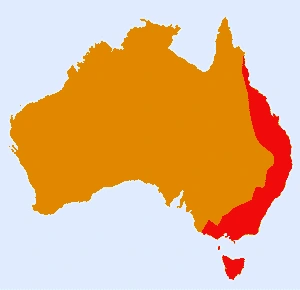
Photo: Platypus in Red Area and Echidna in All
Monotremes are only found in forests, grasslands, and wetlands of Australia and New Guinea.
• Platypus: Prefers heavily wooded tropical, semi-tropical, or temperate climates habitats along rivers, lagoons, and ponds with gravelly or pebbled riverbeds in eastern Australia. These shy animals establish home ranges in these waterways feeding on aquatic creatures.
• Echidna: Live in rocky areas, hollow logs, and tree root crevices, offering protection from harsh weather. These solitary wanderers cover large territories but stay in one place when food is abundant.
What do Monotremes Eat?
Monotremes are carnivorous foragers, relying on electro-receptors at the tips of their beaks to detect prey. They forage for food in the mornings and evenings.
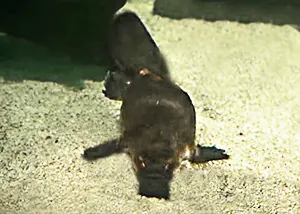
Photo: Platypus foraging for food underwater
• Platypus Diet: Consists of invertebrate prey such as water beetles, water-bugs, snails, shrimp, mussels, seed shrimp, water mites, worms, and small crayfish, which it detects underwater using super-sensitive electro-receptors in its bill. As it does not have teeth, it grinds its food between two bony plates on its upper and lower jaws and swallows this mashed food.
• Echidna Diet: Specializing in ants and termites, echidnas use their nostrils and the electro-receptors at the tip of its beak to detect food, usually hidden inside termite mounds, anthills, rotting logs, and under leaf litter. They use their powerful claws to break into nests and a sticky 15-centimeter-long tongue to lap up prey. Echidnas have no teeth. They use hard pads at the base of their tongues to push food up against the roof of its mouth and grind it into a paste before swallowing.
How Do Monotremes Reproduce?
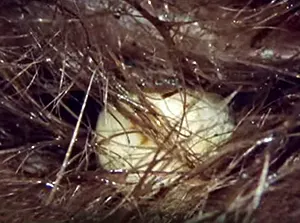
Photo: Platypus egg
Monotremes, unlike other mammals who give birth to live young, lay one to three small leathery eggs.
• Echidna Mother: Lays 1-3 eggs which she carefully places in her backward-facing pouch and incubates them for about two weeks.
• Platypus Mother: Does not have a pouch. She incubates her eggs by placing them in a shallow depression on its belly and holding them in place with its tail until they hatch.
Once hatched, the tiny young lap milk that seeps out of pores in their mother's abdomen. Platypus babies stay in burrows for 3-4 months, while young echidnas remain in the pouch for about 3 months before becoming independent.
Monotreme Threats & Predators
Monotremes have adapted well to their environments, but they still face challenges.
• Echidna: The echidna’s spiky defences and burrowing skills offer it good protection, and attacks on them are rarely successful. However, Tasmanian devils and dingoes prey on them. Australian bushfires are the most significant threat to echidnas as they are too slow to run away from them.
• Platypus: Fall prey to dingoes, large birds of prey, and crocodiles. However its watery environment and venomous spurs offer it sufficient protection from predators. The drying out of waterways can severely affect the viability of platypuses.
Monotreme Conservation Status Is the echidna Endangered?
Currently, monotremes are not considered endangered. They are protected under Australian law, making it illegal to capture, harm, or keep them as pets. But bushfires pose a significant threat to echidnas, and waterway drying endangers platypus populations. Conservation efforts focus on habitat protection to ensure these ancient animals continue to thrive.
Prehistoric Monotreme Monotremes Were The Dominate Animals in Australia Once
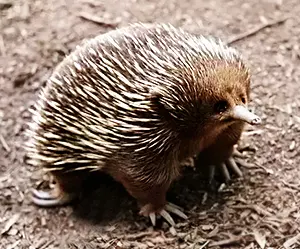
Monotremes were the dominant species in Australia until marsupials arrived 71-54 million years ago and out-competed them. Ultimately, only two types of monotremes survived because they adapted to the water. These surviving species are the echidna, which now lives only on land, and the platypus, which still lives in the water. Genetic analysis indicates that these two species of monotremes diverged about 25-20 million years ago, coinciding with the evolution of the present land-dwelling echidna.
Why Monotremes Matter
Monotremes are more than evolutionary oddities—they’re vital links to our planet’s ancient history. Their unique characteristics provide insights into the early development of mammals, bridging the gap between reptiles and modern mammals. By protecting them, we safeguard not only a part of Australia’s natural heritage but also a living connection to Earth’s distant past.
25 Monotreme Facts
- Monotremes are mammals that lay eggs.
- But they feed their babies milk like mammals.
- They are called monotremes because they have only one rear opening for peeing, pooping and reproduction.
- There are only two types of monotremes; echidnas and platypuses.
- The echidna lives in Australia and New Guinea.
- The platypus only lives in Australia.
- Monotremes have a reptilian gait with their legs splayed out from their sides.
- Other mammals have their legs under their bodies.
- Monotremes have bird-like skulls.
- Males have a spur on their ankles.
- Adult monotremes don’t have teeth.
- They use electro-location, which works like a radar, to find their prey.
- They are carnivorous mammals.
- They search for food in the mornings and evenings.
- Monotremes have a metabolic rate 25-30% lower than other mammals.
- They are warm-blooded but can only control their body temperature in a narrow range of outside temperatures.
- The male penis of a monotreme has four heads.
- They have more in common with marsupials.
- Monotremes lay eggs, hatch them and then feed their babies milk.
- But they don't have nipples.
- Instead, milk oozes from the mother's abdomen, and the babies lick it up.
- Monotremes are relatively common and not considered threatened.
- Monotremes once dominated the Australian landmass.
- That was until marsupials arrived 71—54 million years ago.
- They live for about ten years.
